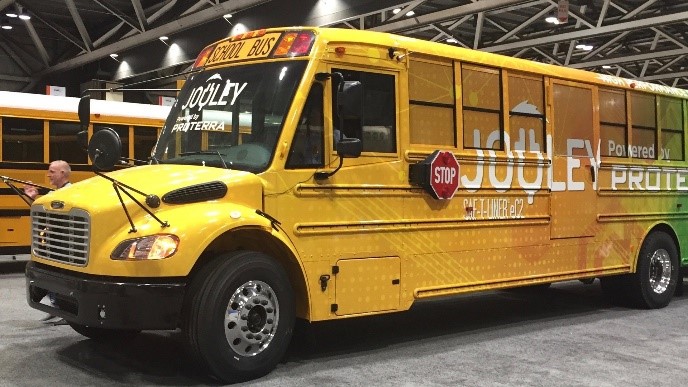
Electric school bus. Image: Michigan Department of Environment, Great Lakes and Energy
By Chloe Trofatter
Capital News Service
Fifteen years ago, Michigan’s first electric hybrid bus was unveiled in Traverse City.
Early editions of those buses proved unreliable. But with the return of the wave of electrification in 2021, has anything changed?
State transit authorities are cautiously optimistic, but trust in technology remains a barrier to the incorporation of electric buses into fleets, according to Jean Ruestman, the administrator of the Office of Passenger Transportation in the Michigan Department of Transportation (MDOT).
“There is risk in implementing new technology,” Ruestman said. “There is still fear regarding how batteries will operate in the cold weather and on rough roads found in our rural areas.”
“Like all new technologies, there are drawbacks. But necessity is the mother of innovation,” said Maureen Marshall, the Midwest regional director of CALSTART. The California-based nonprofit works with businesses and governments to develop clean transportation systems.
The organization is partnering with MDOT to provide guidance in choosing the best use, infrastructure and locations for electric buses across the state.
As more transit agencies switch, the Benzie Transport Authority is waiting for the right product and time, according to Executive Director Bill Kennis.
“We hope in the next six months to a year to be able to purchase two or three vehicles,” he said. “We’re very excited about it, but we want to be good stewards with the public’s money as well.”
The largest drawback, according to Kennis, is the limited range of the battery-powered buses that are currently available.
“They might go a hundred miles and need to be charged. That’s not going to get us through a work day,” he said.
For now, Benzie Bus prides itself on its use of propane to power 90% of its fleet.
“The cool thing about propane is that it is plentiful, so the cost is always very low, and it burns cleaner,” Kennis said.
The Benzie authority was one of six Michigan transit agencies to receive funding for electric buses and charging stations from the Federal Transit Administration’s Low or No Emission program.
Others include the Clare County Transit Corp. and the Capital Area Transportation Authority in Lansing.
The grant gives them three years to identify and purchase the vehicles, according to Kennis.
Kalamazoo Public Schools has had its electric bus for about a year. But because of the nontraditional school year, it hasn’t been able to draw many comparisons with its diesel fleet, according to Mike Smith, the district’s maintenance and transportation supervisor.
The district received funding for its bus after the Volkswagen emissions scandal, or “Dieselgate,” broke in 2015.
The Environmental Protection Agency found that Volkswagen had sold more than 500,000 vehicles with the promise that they were “green” and “low emission.”
In 2017, the company pleaded guilty and agreed to pay $4.3 billion in criminal and civil penalties. $2 billion of that was allocated to a national initiative to fund electric buses and infrastructure.
Kalamazoo Public Schools received enough money to offset the cost of its one electric bus.
“We got a $300,000 bus for $100,000, about the price of a normal bus,” Smith said.
Prior to the COVID-19 pandemic and the shutdown of schools, the bus had its own standard route and completed it daily, like any other bus.
There was a small learning curve, because the layout of the bus is slightly different than its diesel counterparts, according to Smith.
Still, the district looks forward to the predicted savings in maintenance costs, Smith said.
“There’s pros and cons, I think. As we get to using it more and more, we’ll sort of learn what they are,” he said.
Federal commitments to the electrification of public transport have reawakened a national movement to phase out diesel buses, said Christy Veeder, the national program director of Jobs to Move America, a California-based nonprofit organization that wants to root economic development in social justice.
The Biden administration’s American Jobs Plan would double federal spending on public transit and promises to electrify 50,000 diesel transit vehicles.
Bills have been introduced in Congress boosting electric transport.
The CLEAN Future Act from the House Energy and Commerce Committee would commit $25 billion to electric school buses and charging stations.
The BUILD GREEN Act, which would allocate $500 billion over the course of 10 years to electric transit, was introduced to the House by U.S. Rep. Andy Levin, D-Bloomfield Township. U.S. Rep. Rashida Tlaib, D-Detroit, is also a cosponsor.
Jobs to Move America supports the switch to electric buses, not just because of reduced carbon emissions and independence from fossil fuels, but also the negative impacts of diesel buses on occupational and societal health.
Veeder said noise and air pollution from diesel vehicles can harm neighborhoods near bus yards and heavily traveled roads.
Those neighborhoods are disproportionately low-income and communities of color, she said.
Switching to electric buses will improve public health and promote diversity and inclusion in the movement towards renewable energy and electric vehicles, she said.